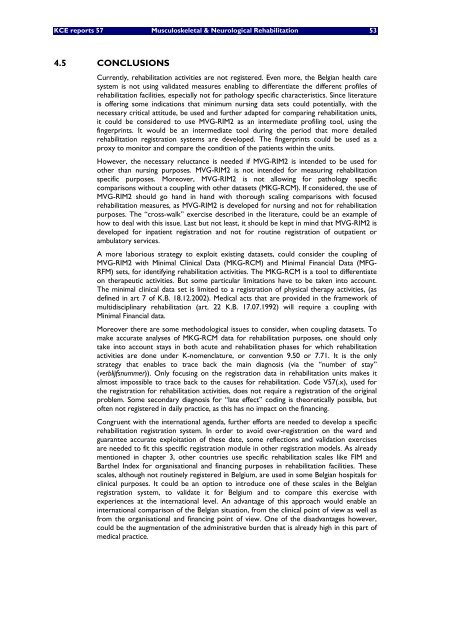The report is available in English with a French summary - KCE
The report is available in English with a French summary - KCE
The report is available in English with a French summary - KCE
You also want an ePaper? Increase the reach of your titles
YUMPU automatically turns print PDFs into web optimized ePapers that Google loves.
<strong>KCE</strong> <strong>report</strong>s 57 Musculoskeletal & Neurological Rehabilitation 53<br />
4.5 CONCLUSIONS<br />
Currently, rehabilitation activities are not reg<strong>is</strong>tered. Even more, the Belgian health care<br />
system <strong>is</strong> not us<strong>in</strong>g validated measures enabl<strong>in</strong>g to differentiate the different profiles of<br />
rehabilitation facilities, especially not for pathology specific character<strong>is</strong>tics. S<strong>in</strong>ce literature<br />
<strong>is</strong> offer<strong>in</strong>g some <strong>in</strong>dications that m<strong>in</strong>imum nurs<strong>in</strong>g data sets could potentially, <strong>with</strong> the<br />
necessary critical attitude, be used and further adapted for compar<strong>in</strong>g rehabilitation units,<br />
it could be considered to use MVG-RIM2 as an <strong>in</strong>termediate profil<strong>in</strong>g tool, us<strong>in</strong>g the<br />
f<strong>in</strong>gerpr<strong>in</strong>ts. It would be an <strong>in</strong>termediate tool dur<strong>in</strong>g the period that more detailed<br />
rehabilitation reg<strong>is</strong>tration systems are developed. <strong>The</strong> f<strong>in</strong>gerpr<strong>in</strong>ts could be used as a<br />
proxy to monitor and compare the condition of the patients <strong>with</strong><strong>in</strong> the units.<br />
However, the necessary reluctance <strong>is</strong> needed if MVG-RIM2 <strong>is</strong> <strong>in</strong>tended to be used for<br />
other than nurs<strong>in</strong>g purposes. MVG-RIM2 <strong>is</strong> not <strong>in</strong>tended for measur<strong>in</strong>g rehabilitation<br />
specific purposes. Moreover, MVG-RIM2 <strong>is</strong> not allow<strong>in</strong>g for pathology specific<br />
compar<strong>is</strong>ons <strong>with</strong>out a coupl<strong>in</strong>g <strong>with</strong> other datasets (MKG-RCM). If considered, the use of<br />
MVG-RIM2 should go hand <strong>in</strong> hand <strong>with</strong> thorough scal<strong>in</strong>g compar<strong>is</strong>ons <strong>with</strong> focused<br />
rehabilitation measures, as MVG-RIM2 <strong>is</strong> developed for nurs<strong>in</strong>g and not for rehabilitation<br />
purposes. <strong>The</strong> “cross-walk” exerc<strong>is</strong>e described <strong>in</strong> the literature, could be an example of<br />
how to deal <strong>with</strong> th<strong>is</strong> <strong>is</strong>sue. Last but not least, it should be kept <strong>in</strong> m<strong>in</strong>d that MVG-RIM2 <strong>is</strong><br />
developed for <strong>in</strong>patient reg<strong>is</strong>tration and not for rout<strong>in</strong>e reg<strong>is</strong>tration of outpatient or<br />
ambulatory services.<br />
A more laborious strategy to exploit ex<strong>is</strong>t<strong>in</strong>g datasets, could consider the coupl<strong>in</strong>g of<br />
MVG-RIM2 <strong>with</strong> M<strong>in</strong>imal Cl<strong>in</strong>ical Data (MKG-RCM) and M<strong>in</strong>imal F<strong>in</strong>ancial Data (MFG-<br />
RFM) sets, for identify<strong>in</strong>g rehabilitation activities. <strong>The</strong> MKG-RCM <strong>is</strong> a tool to differentiate<br />
on therapeutic activities. But some particular limitations have to be taken <strong>in</strong>to account.<br />
<strong>The</strong> m<strong>in</strong>imal cl<strong>in</strong>ical data set <strong>is</strong> limited to a reg<strong>is</strong>tration of physical therapy activities, (as<br />
def<strong>in</strong>ed <strong>in</strong> art 7 of K.B. 18.12.2002). Medical acts that are provided <strong>in</strong> the framework of<br />
multid<strong>is</strong>cipl<strong>in</strong>ary rehabilitation (art. 22 K.B. 17.07.1992) will require a coupl<strong>in</strong>g <strong>with</strong><br />
M<strong>in</strong>imal F<strong>in</strong>ancial data.<br />
Moreover there are some methodological <strong>is</strong>sues to consider, when coupl<strong>in</strong>g datasets. To<br />
make accurate analyses of MKG-RCM data for rehabilitation purposes, one should only<br />
take <strong>in</strong>to account stays <strong>in</strong> both acute and rehabilitation phases for which rehabilitation<br />
activities are done under K-nomenclature, or convention 9.50 or 7.71. It <strong>is</strong> the only<br />
strategy that enables to trace back the ma<strong>in</strong> diagnos<strong>is</strong> (via the “number of stay”<br />
(verblijfsnummer)). Only focus<strong>in</strong>g on the reg<strong>is</strong>tration data <strong>in</strong> rehabilitation units makes it<br />
almost impossible to trace back to the causes for rehabilitation. Code V57(.x), used for<br />
the reg<strong>is</strong>tration for rehabilitation activities, does not require a reg<strong>is</strong>tration of the orig<strong>in</strong>al<br />
problem. Some secondary diagnos<strong>is</strong> for “late effect” cod<strong>in</strong>g <strong>is</strong> theoretically possible, but<br />
often not reg<strong>is</strong>tered <strong>in</strong> daily practice, as th<strong>is</strong> has no impact on the f<strong>in</strong>anc<strong>in</strong>g.<br />
Congruent <strong>with</strong> the <strong>in</strong>ternational agenda, further efforts are needed to develop a specific<br />
rehabilitation reg<strong>is</strong>tration system. In order to avoid over-reg<strong>is</strong>tration on the ward and<br />
guarantee accurate exploitation of these date, some reflections and validation exerc<strong>is</strong>es<br />
are needed to fit th<strong>is</strong> specific reg<strong>is</strong>tration module <strong>in</strong> other reg<strong>is</strong>tration models. As already<br />
mentioned <strong>in</strong> chapter 3, other countries use specific rehabilitation scales like FIM and<br />
Barthel Index for organ<strong>is</strong>ational and f<strong>in</strong>anc<strong>in</strong>g purposes <strong>in</strong> rehabilitation facilities. <strong>The</strong>se<br />
scales, although not rout<strong>in</strong>ely reg<strong>is</strong>tered <strong>in</strong> Belgium, are used <strong>in</strong> some Belgian hospitals for<br />
cl<strong>in</strong>ical purposes. It could be an option to <strong>in</strong>troduce one of these scales <strong>in</strong> the Belgian<br />
reg<strong>is</strong>tration system, to validate it for Belgium and to compare th<strong>is</strong> exerc<strong>is</strong>e <strong>with</strong><br />
experiences at the <strong>in</strong>ternational level. An advantage of th<strong>is</strong> approach would enable an<br />
<strong>in</strong>ternational compar<strong>is</strong>on of the Belgian situation, from the cl<strong>in</strong>ical po<strong>in</strong>t of view as well as<br />
from the organ<strong>is</strong>ational and f<strong>in</strong>anc<strong>in</strong>g po<strong>in</strong>t of view. One of the d<strong>is</strong>advantages however,<br />
could be the augmentation of the adm<strong>in</strong><strong>is</strong>trative burden that <strong>is</strong> already high <strong>in</strong> th<strong>is</strong> part of<br />
medical practice.

















